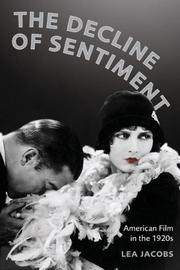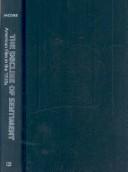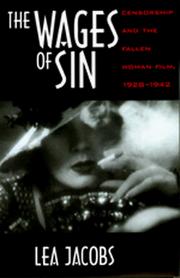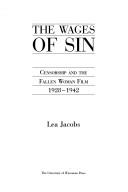| Listing 1 - 10 of 10 |
Sort by
|
Book
ISBN: 9780520279650 9780520279643 9780520960015 0520279646 0520279654 0520960017 Year: 2015 Publisher: Oakland, Calif. University of California Press
Abstract | Keywords | Export | Availability | Bookmark
 Loading...
Loading...Choose an application
- Reference Manager
- EndNote
- RefWorks (Direct export to RefWorks)
The seemingly effortless integration of sound, movement, and editing in films of the late 1930's stands in vivid contrast to the awkwardness of the first talkies. Film Rhythm after Sound analyzes this evolution via close examination of important prototypes of early sound filmmaking, as well as contemporary discussions of rhythm, tempo, and pacing. Jacobs looks at the rhythmic dimensions of performance and sound in a diverse set of case studies: the Eisenstein-Prokofiev collaboration Ivan the Terrible, Disney's Silly Symphonies and early Mickey Mouse cartoons, musicals by Lubitsch and Mamoulian, and the impeccably timed dialogue in Hawks's films. Jacobs argues that the new range of sound technologies made possible a much tighter synchronization of music, speech, and movement than had been the norm with the live accompaniment of silent films. Filmmakers in the early years of the transition to sound experimented with different technical means of achieving synchronization and employed a variety of formal strategies for creating rhythmically unified scenes and sequences. Music often served as a blueprint for rhythm and pacing, as was the case in mickey mousing, the close integration of music and movement in animation. However, by the mid-1930s, filmmakers had also gained enough control over dialogue recording and editing to utilize dialogue to pace scenes independently of the music track. Jacobs's highly original study of early sound-film practices provides significant new contributions to the fields of film music and sound studies.
Sound in motion pictures. --- Motion picture music. --- Dialogue in motion pictures. --- Motion pictures --- Rhythm. --- Son au cinéma --- Film, Musique de --- Dialogue au cinéma --- Cinéma --- Rythme --- Production and direction. --- Production et réalisation --- PERFORMING ARTS --- Reference. --- Film & Video --- General. --- Music --- Film --- Performing arts --- Film & video --- Son au cinéma --- Dialogue au cinéma --- Cinéma --- Production et réalisation --- Aesthetics --- Movement, Psychology of --- Poetics --- Cycles --- Movement, Aesthetics of --- Direction of motion pictures --- Film-making (Motion pictures) --- Filmmaking (Motion pictures) --- Motion picture direction --- Motion picture plays --- Motion picture production --- Movie-making --- Moviemaking --- Production of motion pictures --- Film dialogue --- Movie dialogue --- Background music for motion pictures --- Film music --- Film scores --- Movie music --- Moving-picture music --- Dramatic music --- Production and direction --- Direction --- animated films. --- animation. --- case studies. --- dialogue. --- disneys silly symphonies. --- eisenstein-prokofiev collaboration. --- film and television. --- film editing. --- film history. --- film music. --- film rhythm. --- film studies. --- film. --- filmmaking. --- first talkies. --- ivan the terrible. --- mickey mouse cartoons. --- movement in film. --- movies. --- music track. --- musicals. --- pacing. --- performance and sound. --- rhythm. --- sound film practices. --- sound in film. --- sound studies. --- sound technologies. --- sound. --- synchronized sound. --- technology. --- tempo.

ISBN: 9780520254572 9780520237018 0520237013 0520254570 Year: 2008 Publisher: Berkeley University of California press
Abstract | Keywords | Export | Availability | Bookmark
 Loading...
Loading...Choose an application
- Reference Manager
- EndNote
- RefWorks (Direct export to RefWorks)
Cinéma mélodramatique --- Films mélodramatiques --- Films mélos --- Melodrama in de film --- Melodrama in motion pictures --- Mélodrame au cinéma --- Mélodrames (Cinéma) --- Mélodrames (Films) --- Mélodrames filmiques --- Mélos (Films) --- Film --- anno 1920-1929 --- United States --- 82:791.43 --- 82:791.43 Literatuur en film --- Literatuur en film --- Motion pictures --- Silent films --- Melodrama in motion pictures. --- Cinéma --- Films muets --- Mélodrame au cinéma --- History. --- Histoire --- Moving pictures, Silent --- Silent motion pictures --- History --- History and criticism --- United States of America

ISBN: 1282360507 9786612360503 0520941535 9780520941533 9781282360501 0520237013 0520254570 9780520237018 9780520254572 Year: 2008 Publisher: Berkeley : University of California Press,
Abstract | Keywords | Export | Availability | Bookmark
 Loading...
Loading...Choose an application
- Reference Manager
- EndNote
- RefWorks (Direct export to RefWorks)
The Decline of Sentiment seeks to characterize the radical shifts in taste that transformed American film in the jazz age. Based upon extensive reading of trade papers and the popular press of the day, Lea Jacobs documents the films and film genres that were considered old-fashioned, as well as those dubbed innovative and up-to-date, and looks closely at the works of filmmakers such as Erich von Stroheim, Charlie Chaplin, Ernst Lubitsch, and Monta Bell, among many others. Her analysis-focusing on the influence of literary naturalism on the cinema, the emergence of sophisticated comedy, and the progressive alteration of the male adventure story and the seduction plot-is a comprehensive account of the modernization of classical Hollywood film style and narrative form.
Melodrama in motion pictures. --- Silent films --- Motion pictures --- Moving pictures, Silent --- Silent motion pictures --- History. --- History and criticism. --- 20th century american film. --- american cinema. --- american film. --- charlie chaplin. --- comedy. --- erich von stroheim. --- ernst lubitsch. --- film genres. --- film history. --- film studies. --- film style. --- film. --- filmmakers. --- history. --- hollywood. --- jazz age. --- literary naturalism. --- male adventure story. --- modernization of classical hollywood. --- monta bell. --- movie history. --- movie studies. --- movies. --- narrative form. --- romantic drama. --- seduction plot. --- sentimental art. --- sentimental films. --- sophisticated film. --- trade papers.

ISBN: 0520207904 Year: 1997 Publisher: Berkeley : University of California Press,
Abstract | Keywords | Export | Availability | Bookmark
 Loading...
Loading...Choose an application
- Reference Manager
- EndNote
- RefWorks (Direct export to RefWorks)
Motion pictures --- Sex in motion pictures. --- Women in motion pictures. --- Censorship --- History.
Book
Year: 1991 Publisher: Madison, Wis. University of Wisconsin
Abstract | Keywords | Export | Availability | Bookmark
 Loading...
Loading...Choose an application
- Reference Manager
- EndNote
- RefWorks (Direct export to RefWorks)

ISBN: 0299128849 Year: 1991 Publisher: London University of Wisconsin press
Abstract | Keywords | Export | Availability | Bookmark
 Loading...
Loading...Choose an application
- Reference Manager
- EndNote
- RefWorks (Direct export to RefWorks)
Motion pictures --- Sex in motion pictures --- Women in motion pictures --- Censorship --- History

ISBN: 0198182678 0198259501 0198159501 9780198159506 9780198182672 Year: 1997 Publisher: London Oxford university
Abstract | Keywords | Export | Availability | Bookmark
 Loading...
Loading...Choose an application
- Reference Manager
- EndNote
- RefWorks (Direct export to RefWorks)
Motion pictures and theater. --- Motion pictures --- Cinéma et théâtre --- Cinéma --- History. --- Histoire --- Cinéma et théâtre --- Cinéma --- #SBIB:309H1320 --- Ben Brewster and Lea Jacobs --- precinema --- filmgeschiedenis --- voorgeschiedenis film --- film en theater --- 791.02 --- De filmische boodschap: algemene werken (met inbegrip van algemeen filmhistorische werken en filmhistorische werken per land) --- #SBIB:AANKOOP --- film --- 791.43 --- CDL
Dissertation
Year: 1961 Publisher: Berlaar Hogere normaalschool voor landbouwhuishoudkunde Berlaar
Abstract | Keywords | Export | Availability | Bookmark
 Loading...
Loading...Choose an application
- Reference Manager
- EndNote
- RefWorks (Direct export to RefWorks)
Dissertation
Abstract | Keywords | Export | Availability | Bookmark
 Loading...
Loading...Choose an application
- Reference Manager
- EndNote
- RefWorks (Direct export to RefWorks)
Book

ISBN: 1282562479 1780347871 9786612562471 0813549299 9780813549293 9780813547312 0813547318 9780813547329 0813547326 0813547318 9780813547312 Year: 2010 Publisher: New Brunswick, NJ
Abstract | Keywords | Export | Availability | Bookmark
 Loading...
Loading...Choose an application
- Reference Manager
- EndNote
- RefWorks (Direct export to RefWorks)
With its sharp focus on stardom during the 1920's, Idols of Modernity reveals strong connections and dissonances in matters of storytelling and performance that can be traced both backward and forward, across Europe, Asia, and the United States, from the silent era into the emergence of sound. Bringing together the best new work on cinema and stardom in the 1920's, this illustrated collection showcases the range of complex social, institutional, and aesthetic issues at work in American cinema of this time. Attentive to stardom as an ensemble of texts, contexts, and social phenomena stretching beyond the cinema, major scholars provide careful analysis of the careers of both well-known and now forgotten stars of the silent and early sound era-Douglas Fairbanks, Buster Keaton, the Talmadge sisters, Rudolph Valentino, Gloria Swanson, Clara Bow, Colleen Moore, Greta Garbo, Anna May Wong, Emil Jannings, Al Jolson, Ernest Morrison, Noble Johnson, Evelyn Preer, Lincoln Perry, and Marie Dressler.
Motion picture actors and actresses --- Actors --- Actresses
| Listing 1 - 10 of 10 |
Sort by
|

 Search
Search Feedback
Feedback About UniCat
About UniCat  Help
Help News
News